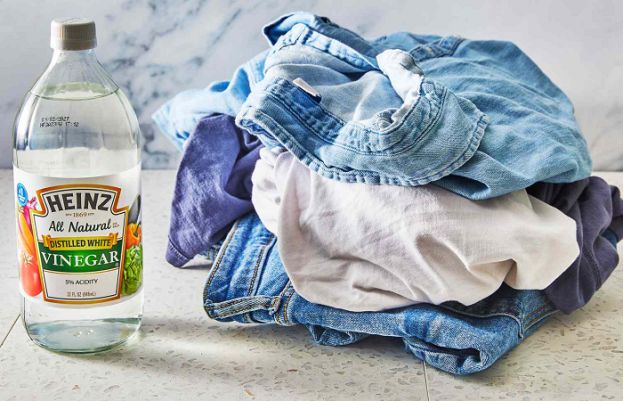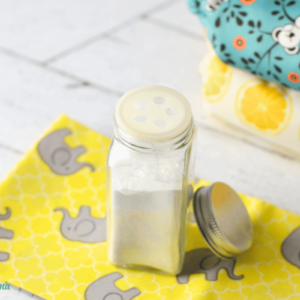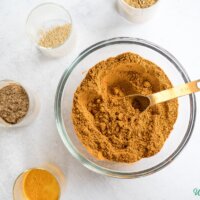
Vinegar is a veritable powerhouse when it comes to pretreating stains, softening water and boosting regular laundry detergents. When cleaning fabrics, white distilled vinegar is preferred, but apple cider vinegar works just as well if that’s what you have on hand.
This article includes a number of ways you can use vinegar in laundry. We’ll start with the basics, but note that none of the tips listed here should be tried with dry-clean-only fabrics.
How to Use Vinegar in Laundry
Vinegar works as a natural fabric softener. Unlike commercial fabric softeners, it’s cheap and doesn’t rely on harsh chemicals.
Distilled white vinegar can also neutralize odors, giving your clothes a fresh scent by removing odor-causing buildup. And don’t worry — as long as you use laundry detergent, your clothes won’t smell like vinegar.
Here’s how to soften fabrics and remove strong odors for different garments and situations.
Blankets: When washing cotton or washable wool blankets, add 2 cups (473 mL) of undiluted vinegar to the last rinse cycle. This will help remove the soap and make blankets soft and fluffy.
Clothes softener: Add 1/2 cup (118 mL) of vinegar to the fabric softener dispenser during the final rinse cycle of your wash to soften clothes.
Lint: Reduce lint buildup and keep pet hair from clinging to clothing by adding vinegar to the last rinse cycle.
New clothes: Some new clothes may be treated with a chemical that can be irritating to sensitive skin. Soak new clothing in 1 gallon (3.8 L) of water with 1/2 cup (118 mL) of vinegar. Rinse, then wash as usual.
Static cling: A good way to control static cling is to add 1/2 cup (473118mL) of vinegar to the last rinse cycle of your wash.
Special Fabrics
Be extra careful when using any chemicals, including vinegar, on delicate fabrics. Test the solution on an unnoticeable part of the item before washing the entire garment.
Delicates: If you’re washing delicate items by hand, follow the garment’s care instructions, and add 1 or 2 tablespoons (14 to 30 mL) of vinegar to the last rinse to help remove soap residue.
Leather: Clean leather with a mixture of 1 cup (237 mL) of boiled linseed oil and 1 cup of vinegar. Carefully apply to any spots with a soft cloth. Let dry.
Silk: Dip silks (do not soak) in a mixture of 1/2 cup (118 mL) of mild detergent, 2 tablespoons (30 mL) of vinegar and 2 quarts (1.9 L) of cold water. Rinse well, then roll in a heavy towel to soak up the excess moisture. Iron while still damp.
Vinegar Brightens Clothes
Vinegar can work magic when it comes to washing colored garments and removing stains. Here’s how:
Colors: Any colored clothing item that has become dulled can be brightened by soaking it in 1 gallon warm water and 1 cup (237 mL) of vinegar. Follow this with a clear water rinse.
Yellowing: When hand-washing linen, wool or silk, prevent them from yellowing by adding 1/2 cup (118 mL) of vinegar to the rinse water.
Vinegar Removes Stains
Vinegar is a great ally in the fight against laundry stains. Here are a few examples:
Coffee and tea: For coffee stains or tea stains that have set, soak the item in a solution of 1/3 cup (78 mL) of vinegar to 2/3 cup (156 mL) of water, then hang the garment out in the sun to dry.
Grass: Removal of severe grass stains on white clothes can be helped along by soaking them in full-strength vinegar for a half-hour before washing.
Gum: If sticky spots remain after removing a piece of gum from clothing, soak gum stains in vinegar for 10 to 15 minutes. Launder as usual.
Ink: An older ink stain in cotton fabric may be helped by spraying with hair spray. Dab with vinegar to remove the sticky spray.
Juice: Dried red berry juice may be removed from bleach-safe garments by soaking it in a solution of one part vinegar to two parts water. Then wash as usual.
Mildew: A mixture of salt, vinegar and water should remove mildew stains on most fabrics. Use up to full-strength vinegar if mildew is extensive.
Pretreatment: For synthetic blends or old stains on natural materials, presoak the stain in ammonia before applying vinegar and water.
A basic mixture of half water and half vinegar as a laundry pretreatment can do the trick with many common stains on clothing. Keep a spray bottle of this in your laundry room. Spray mixture on the stains before washing to give an extra boost.
As you’ve seen, vinegar can be of great help when it’s time to do laundry. You’re probably wonder why it’s taken you this long to add vinegar to your laundry routine; it’s certainly better than buying new clothes.
A Vinegar-Based Rust-Removal and Stain-Removal Paste
Make a thin paste of vinegar and salt, then spread the paste on rust stains in fabric. Lay the item out in the sun to bleach, or apply paste, stretch fabric over a large kettle, and pour boiling water through the stained area.
In both cases, allow the item to dry, then check the stain. Run the item through the rinse cycle in the washing machine, then check the stain again. Repeat treatment if any stain remains.
Vinegar Stain Pretreatment Solution
Keep this pretreatment solution on hand in the laundry room to use on virtually all tough clothing stains. Just combine:
1/2 cup (118 mL) vinegar
1/2 cup (118 mL) ammonia
1/2 cup (60 g) baking soda
2 squirts liquid soap
2 quarts (1.9 L) water
Keep the solution in a clearly labeled spray bottle.





